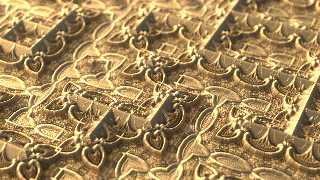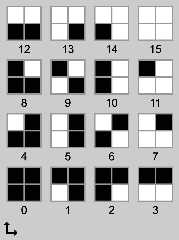 |
 |
|
 |
|
 |
|  |
|  |
|
 |
|
 |
|  |
|  |
|
 |
Hi all,
I'm pretty much just checking in to say hi. Hi!
This image uses clipped height fields and a technique resembling marching
squares. Just messing around, pretty much. Hope everyone's doing well!
Sam
Post a reply to this message
Attachments:
Download 'tilefinder23m_03s+1m_32s.jpg' (265 KB)
Preview of image 'tilefinder23m_03s+1m_32s.jpg'

|
 |
|  |
|  |
|
 |
|
 |
|  |
|  |
|
 |
Op 02/03/2020 om 00:11 schreef Samuel B.:
> Hi all,
>
> I'm pretty much just checking in to say hi. Hi!
>
> This image uses clipped height fields and a technique resembling marching
> squares. Just messing around, pretty much. Hope everyone's doing well!
>
> Sam
>
Sam! How good to hear from you! How are you doing? Well, I suppose,
seeing that gorgeous pure gold artifact you must have found in the
desert. :-)
--
Thomas
Post a reply to this message
|
 |
|  |
|  |
|
 |
|
 |
|  |
|  |
|
 |
Samuel B. wrote on 02/03/2020 00:11:
> Hi all,
>
> I'm pretty much just checking in to say hi. Hi!
>
> This image uses clipped height fields and a technique resembling marching
> squares. Just messing around, pretty much. Hope everyone's doing well!
>
> Sam
>
Very intriguing, as always, Sam!
Paolo
Post a reply to this message
|
 |
|  |
|  |
|
 |
|
 |
|  |
|  |
|
 |
"Samuel B." <stb### [at] hotmail com> wrote:
> Hi all,
Great to see you're still producing the goods! Lovely image as always.
Bill com> wrote:
> Hi all,
Great to see you're still producing the goods! Lovely image as always.
Bill
Post a reply to this message
|
 |
|  |
|  |
|
 |
|
 |
|  |
|  |
|
 |
Thomas de Groot <tho### [at] degroot org> wrote:
>
> Sam! How good to hear from you! How are you doing? Well, I suppose,
> seeing that gorgeous pure gold artifact you must have found in the
> desert. :-)
On average: ok ;) Yourself? org> wrote:
>
> Sam! How good to hear from you! How are you doing? Well, I suppose,
> seeing that gorgeous pure gold artifact you must have found in the
> desert. :-)
On average: ok ;) Yourself?
Post a reply to this message
|
 |
|  |
|  |
|
 |
|
 |
|  |
|  |
|
 |
"Samuel B." <stb### [at] hotmail com> wrote:
> Hi all,
>
> I'm pretty much just checking in to say hi. Hi!
>
> This image uses clipped height fields and a technique resembling marching
> squares. Just messing around, pretty much. Hope everyone's doing well!
>
> Sam
Hi Samuel,
I know your clipped height fields code, but I don't get the marching squares
part.
Is it similar to your code for Randomized orientation of pattern instances?
And - your image is simple, but beautiful!
Hopefully you will make and publish more povray images.
Regards,
Norbert com> wrote:
> Hi all,
>
> I'm pretty much just checking in to say hi. Hi!
>
> This image uses clipped height fields and a technique resembling marching
> squares. Just messing around, pretty much. Hope everyone's doing well!
>
> Sam
Hi Samuel,
I know your clipped height fields code, but I don't get the marching squares
part.
Is it similar to your code for Randomized orientation of pattern instances?
And - your image is simple, but beautiful!
Hopefully you will make and publish more povray images.
Regards,
Norbert
Post a reply to this message
|
 |
|  |
|  |
|
 |
|
 |
|  |
|  |
|
 |
Op 02/03/2020 om 23:03 schreef Samuel B.:
> Thomas de Groot <tho### [at] degroot org> wrote:
>>
>> Sam! How good to hear from you! How are you doing? Well, I suppose,
>> seeing that gorgeous pure gold artifact you must have found in the
>> desert. :-)
>
> On average: ok ;) Yourself?
>
Hobbling along but I don't complain ;-)
--
Thomas org> wrote:
>>
>> Sam! How good to hear from you! How are you doing? Well, I suppose,
>> seeing that gorgeous pure gold artifact you must have found in the
>> desert. :-)
>
> On average: ok ;) Yourself?
>
Hobbling along but I don't complain ;-)
--
Thomas
Post a reply to this message
|
 |
|  |
|  |
|
 |
|
 |
|  |
|  |
|
 |
"Norbert Kern" <nor### [at] t-online de> wrote:
> "Samuel B." <stb### [at] hotmail de> wrote:
> "Samuel B." <stb### [at] hotmail com> wrote:
> > Hi all,
> >
> > I'm pretty much just checking in to say hi. Hi!
> >
> > This image uses clipped height fields and a technique resembling marching
> > squares. Just messing around, pretty much. Hope everyone's doing well!
> >
> > Sam
>
>
> Hi Samuel,
>
> I know your clipped height fields code, but I don't get the marching squares
> part.
> Is it similar to your code for Randomized orientation of pattern instances?
>
> And - your image is simple, but beautiful!
> Hopefully you will make and publish more povray images.
>
> Regards,
> Norbert
Hi Norbert,
I'm not sure I ever posted the thing I'm doing here. Attached is a 'cheat sheet'
showing how I figure out which tiles get used. There are 6 basic tiles: solid,
empty, outside corner, inside corner, wall, and 'bridge' which is two outside or
inside corners. I test four cells of a pattern to determine which tile gets
used. The cells are evaluated and counted starting from the bottom left. The
counting algorithm is 1*SW + 2*SE + 4*NW + 8*NE to obtain a decimal number from
the four 2 bit cells. Then I use that number to access objects created with the
cheat sheet in mind. For instance, number 1 is an outside corner facing the
upper right.
Sorry if that's confusing at all :P At any rate, I can provide the source if you
want.
Sam com> wrote:
> > Hi all,
> >
> > I'm pretty much just checking in to say hi. Hi!
> >
> > This image uses clipped height fields and a technique resembling marching
> > squares. Just messing around, pretty much. Hope everyone's doing well!
> >
> > Sam
>
>
> Hi Samuel,
>
> I know your clipped height fields code, but I don't get the marching squares
> part.
> Is it similar to your code for Randomized orientation of pattern instances?
>
> And - your image is simple, but beautiful!
> Hopefully you will make and publish more povray images.
>
> Regards,
> Norbert
Hi Norbert,
I'm not sure I ever posted the thing I'm doing here. Attached is a 'cheat sheet'
showing how I figure out which tiles get used. There are 6 basic tiles: solid,
empty, outside corner, inside corner, wall, and 'bridge' which is two outside or
inside corners. I test four cells of a pattern to determine which tile gets
used. The cells are evaluated and counted starting from the bottom left. The
counting algorithm is 1*SW + 2*SE + 4*NW + 8*NE to obtain a decimal number from
the four 2 bit cells. Then I use that number to access objects created with the
cheat sheet in mind. For instance, number 1 is an outside corner facing the
upper right.
Sorry if that's confusing at all :P At any rate, I can provide the source if you
want.
Sam
Post a reply to this message
Attachments:
Download 'tile chart.png' (9 KB)
Preview of image 'tile chart.png'

|
 |
|  |
|  |
|
 |
|
 |
|  |
|  |
|
 |
> Sorry if that's confusing at all :P At any rate, I can provide the source if you
> want.
>
> Sam
I failed to mention that the fancy pattern is obtained via iterated transforms
and a warp{repeat x flip x} statement. This produces fractals :)
Post a reply to this message
|
 |
|  |
|  |
|
 |
|
 |
|  |
|  |
|
 |
"Samuel B." <stb### [at] hotmail com> wrote:
> Hi Norbert,
>
> I'm not sure I ever posted the thing I'm doing here. Attached is a 'cheat sheet'
> showing how I figure out which tiles get used. There are 6 basic tiles: solid,
> empty, outside corner, inside corner, wall, and 'bridge' which is two outside or
> inside corners. I test four cells of a pattern to determine which tile gets
> used. The cells are evaluated and counted starting from the bottom left. The
> counting algorithm is 1*SW + 2*SE + 4*NW + 8*NE to obtain a decimal number from
> the four 2 bit cells. Then I use that number to access objects created with the
> cheat sheet in mind. For instance, number 1 is an outside corner facing the
> upper right.
>
> Sorry if that's confusing at all :P At any rate, I can provide the source if you
> want.
>
> Sam
I've a clear impression of the algorithm now, but of course I want the source!
Norbert com> wrote:
> Hi Norbert,
>
> I'm not sure I ever posted the thing I'm doing here. Attached is a 'cheat sheet'
> showing how I figure out which tiles get used. There are 6 basic tiles: solid,
> empty, outside corner, inside corner, wall, and 'bridge' which is two outside or
> inside corners. I test four cells of a pattern to determine which tile gets
> used. The cells are evaluated and counted starting from the bottom left. The
> counting algorithm is 1*SW + 2*SE + 4*NW + 8*NE to obtain a decimal number from
> the four 2 bit cells. Then I use that number to access objects created with the
> cheat sheet in mind. For instance, number 1 is an outside corner facing the
> upper right.
>
> Sorry if that's confusing at all :P At any rate, I can provide the source if you
> want.
>
> Sam
I've a clear impression of the algorithm now, but of course I want the source!
Norbert
Post a reply to this message
|
 |
|  |
|  |
|
 |
|
 |
|  |




![]()